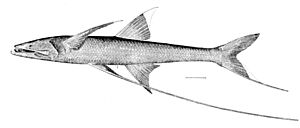Tripodfish facts for kids
Quick facts for kids Tripodfish |
|
|---|---|
 |
|
| Conservation status | |
| Scientific classification |
The tripod fish is an amazing deep-sea creature. It is also known as the tripod spiderfish, or by its scientific name, Bathypterois grallator. This fish lives on the ocean floor in very deep waters. It uses its long, special fins to stand tall, almost like a tripod.
Scientists have taken many pictures of the tripod fish. They have also seen it using special underwater vehicles. It likes to stand on the soft mud of the ocean floor. It faces into the ocean current, using its long fins like antennae to feel for food. The tripod fish is special because it can be both male and female at the same time. There are at least 18 different types of fish in the Bathypterois group. Many of them look and act like the tripod fish. The tripod fish is the biggest in its group. It can grow to be over 30 cm (12 in) long, and sometimes even up to 43.4 cm (17.1 in).
Contents
What Makes the Tripod Fish Special?
The tripod fish is sometimes called the abyssal spiderfish. It has very long, bony rays that stick out from its tail fin. It also has two long rays from its pelvic fins. The main part of the fish's body can be up to 43.4 cm (17.1 in) long. But its special fins can be more than 1 m (3 ft 3 in) long!
Most of the time, the tripod fish stands on these three long fins. It uses them to balance on the ocean floor. This helps it hunt for food. Even though the fins look stiff, they can bend. Scientists have seen the fish swim, and its fins become flexible then. They think the fish pumps fluids into its fins. This makes them stiff when it wants to stand still.
Where Do Tripod Fish Live?
The Bathypterois grallator lives in many parts of the world. You can find it in the Atlantic, Pacific, and Indian oceans. It lives in areas from 40 degrees North to 40 degrees South of the equator. This fish can live in a wide range of depths. It has been found from 878 to 4,720 m (2,881 to 15,486 ft) deep. That's very, very deep!
How Tripod Fish Find Food
The tripod fish doesn't use its eyes much to find food. It's too dark where it lives! Instead, it uses touch and movement to find its meals. When the fish stands on its long fins, its mouth is at the perfect height. It waits for food to float by in the current.
Its front fins act like antennae or even hands. They are turned forward, ready to sense anything. When the fish feels something in the water, it knows if it's food. Then, its fins can gently knock the food right into its mouth. It eats small shrimp, tiny fish, and other small creatures. The tripod fish always faces into the current. This helps it catch prey as it drifts along.
Reproduction and Life Cycle
Each tripod fish is special because it has both male and female parts. This means it can produce both sperm and eggs. If two tripod fish meet, they can mate together. But if a tripod fish doesn't find a partner, it can still have babies. It can produce offspring all by itself! This is a very useful way to survive in the deep ocean.
Related Fish Species
There are at least 18 different kinds of fish in the Bathypterois group. Many of them look and act like the tripod fish. Sometimes, similar species are found in the same areas. For example, Bathypterois dubius has been seen as far north as the Bay of Biscay.
There's another interesting fish called the icefish. Some icefish, like Chionodraco, stand in a similar way to the tripod fish. Both types of fish stay still above the ocean floor. This helps them use their sense of touch and movement to find things.
The tripod fish is also closely related to the spider fish, Bathypterois longifilis. They look alike and have similar habits. However, the spider fish is smaller. It also has much shorter fin extensions. These two fish are often found standing very close to each other. The family they both belong to is called Ipnopidae. It's known as the family of tripod fishes or spiderfishes.


